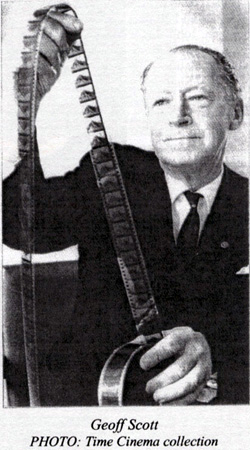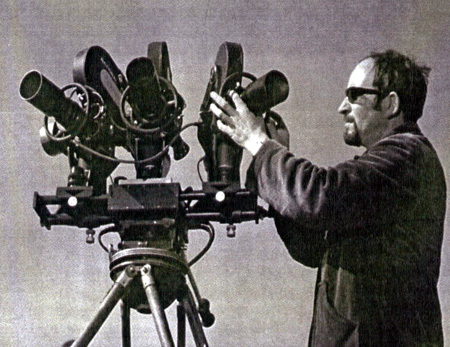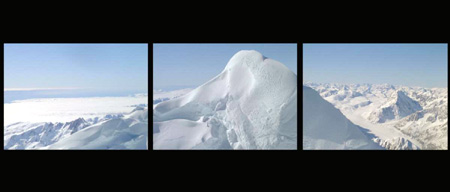"This is New Zealand"
|
Read more
at in70mm.com The 70mm Newsletter |
| Written by and reprinted from: Warren Smyth, "Flicks & Pix" Magazine. With invaluable help from Bob Jessopp. Photo's and Screen Shots courtesy of Archives New Zealand "Te Rua Mahara o te Kawanatanga" | Date: 27.02.2009 |
 Geoff
Scott. Image by Time Cinema Collection Geoff
Scott. Image by Time Cinema CollectionThe Birth of “THIS IS NEW ZEALAND” The late Geoff Scott was manager of the National Film Unit at the time "This Is New Zealand" was produced. He had seen a multi-screen presentation at a previous Expo exhibition in Canada using 70mm film. With an approaching Expo in 1970 this time in Japan, he was determined to showcase New Zealand to the world, using the medium he loved. The following, is a transcript of part of an interview, he gave Warren Smyth 8 years ago. W.S. In the late sixties there was a need to promote New Zealand’s products overseas at Expo in Osaka, tell me about the idea that you had for a very special film presentation. G.S. Initially, we didn’t have permission to make a film at all. I suggested to the Industries and Commerce Dept., who were principally responsible for making New Zealand’s exhibition a success, that they should have a film and they said “No we don’t want a film”. There was to be a pavilion consisting of four main modules at Expo Osaka. I said “I’d like the one on the corner to put a film in” and the Ministry of Commerce said “Oh no, that’s reserved for the Dairy Board or the Meat Board”. I said “I can give people a better idea of New Zealand in twenty minutes looking at a film, than can be done looking at bits and pieces” (The dairy Board had proposed having a series of static displays with a model of a cow). Settling the argument, J. Marshall, then Minister for Industries and Commerce and of Tourist and Publicity, finally called a meeting turning to me he said “Geoff, can you make a film for Osaka, a good one. You’ve got us out of trouble in the past when we’ve wanted publicity, can you do it”? and I said, “Yes, I think I can”. He turned to the Industries and Commerce people and said, “I think we should have a film”. Industries and Commerce, who had been opposing me, then became most co-operative and most helpful. I was conscious that the Japanese were good cinematographers and very colour conscious. There was more film shot in Japan at that time than any other country in the world. The Film had to be spectacular and I couldn’t afford 70mm film. That would have cost a million dollars to shoot, so I decided to use a three screen presentation. Using three cameras and projectors to project three images side by side, you could use either of the three screens for separate images, or the whole three to open out into a terrific panorama. Three 35mm films gave 105mm of film surface width, instead of 35mm, so the resolution and quality of reproduction would be tremendous. |
More
in 70mm reading: Widescreen Weekend 2009, Bradford, England Internet link: From Scoop 37th Wellington Film Festival See a clip from the film here Bob Jessopp: I have decided to have a print run of the programme done (100) and bring with me. Hopefully I can find enough people interested to cover cost of Run. This has interviews with the Director, the Producers and people that worked on the filming and projection, plus photos etc. Quite a good souvenir. Perhaps you could advise they are available at the meeting. Sounds like I'm not the only film buff that works till all ours. Bob Jessopp: I had organised clearance for this from the National Film Archives through a friend and I believe Bill Lawrence was looking after this. It has now been put onto single 35mm film and looks mighty. I saw it projected onto a 100ft screen and it had people in the audience in tears. I kid you not. I am sure if you do screen it you will not be disappointed. Screened at the Widescreen Weekend 2009, Bradford, England |
 Cameraman
Ken Fowler Cameraman
Ken FowlerThe film unit’s staff were the first to react. They said, “You can’t do it, it will never work” I said “It will work all right, I’ve made an agreement to produce this and take it to Japan and I’m going to do it”. I got the cameraman and Hugh Macdonald in and I said “ Hugh, you are going to be the director of this, you write a script” I wrote a script for it that came very close to the final result, but Hugh doctored it up. He produced this thing with Kell Fowler, chief cameraman and Sam Grau (from Barcelona) as well as all the other cameramen. Everybody got in behind it. We had to go through a lot of growing pains. The sound dept. did a wonderful job with Claude Wickstead in charge. We had three magnetic sound tracks operating with multiple speakers. Everyone was astounded when we had a preview screening at the film Unit. Muldoon came out. I said “Well you’re the Minister of Finance, it’s come within budget” He said “I don’t believe it, I wouldn’t have minded if it had gone over a bit, I’m astounded”. Marshall at the end was in tears with emotion, as were others. We drew plans for the construction and sent a crew over to Osaka to install the equipment with Mc Ashley as manager. W.S. How did the Japanese receive it? G.S. They presented 21 sessions every day. One and a half million people saw it and "This Is New Zealand" was the star attraction at Expo 70. |
27 Feb 2009 Thanks for "This is New Zealand" Saw this in Auckland at the Embassy Theatre which was specially reconstructed for the projectors, it was a big hit and reminded me of the earlier Cinerama. Thanks Mark Nicol 28 Feb 2009 Just had a look at the website. You have done a lovely job, thank you so much. You have really gone the extra mile. People here are going to be so pleased. Kind regards Bob Jessopp |
 Click
on image to see enlargement Click
on image to see enlargementW.S. Jack Marshall wanted it run in NZ? G.S. Yes this was a problem. We were planning to run it in the USA as we needed more tourism from there. Jack Marshall said, “No Geoff, I want it brought back to New Zealand, New Zealanders must have the opportunity of seeing this” I Said,” How are you going to do that”? He said “I don’t know, that’s your job and you do it! Bring it back and exhibit it in New Zealand”. Now this was a problem because no theatre projection box in New Zealand could accommodate four machines (Including the Sound Unit) but eventually I went up to Kerridge (Owner of the cinema chain Kerridge Odeon) and said “Can you give me the Embassy theatre in Wellington for a couple of weeks, while I get rid of this headache? The embassy has got the widest screen and I can put equipment on the ground floor” We couldn’t screen it at 2pm and 8pm because of theatre contractual obligations, so I decided that we would screen it at 11;, 12, 1 and then 5, 6, and 7pm. Screenings’ were added at 9 and 10pm to accommodate school groups and booked busloads of people from the Lower Hutt area. Kerridge said “You’ll never get anyone to come out at those times. It won’t work” and I said, “Further more, we will charge 20c and 40c that’s all” He said “Good gracious me, you’ll never make any money”. |
|
 W.S.
How was it received in NZ? W.S.
How was it received in NZ?G.S. Well, the reception at the Embassy was amazing. It opened to crowds waiting in queues all the way up Kent Terrace. The Theatre was full, and the next session was full, with people waiting. The 5, 6 and 7pm sessions were also full and it ran, instead of an expected couple of weeks, thirteen weeks. With screenings increasing to eight per day, six days a week. The money that was taken paid for the total production cost in the one theatre-never been done to my knowledge. The film had a fantastic reception, largely due to the Listener editor who was overwhelmed by it and who gave us great big spreads. The enthusiasm of reporters and editors of newspaper also gave it a great break. We took it to the Odeon Christchurch were it continued it’s success, with ten screenings a day, and then, on to a sensational reception in Dunedin. The show then went to the Embassy in Auckland, where four rows of seats had to be pulled out, for the construction of a wide projection box. This was the most difficult New Zealand location of all. |
|
About "This is New Zealand" |
|
|
From 37th Wellington Film Festival web site: Director: Hugh Macdonald.
Year: 1969. Running time: 58 mins. NZ. Screenplay/Editors: Hugh
Macdonald, David Jordan. Associate directors: David Jordan, Rob Ritchie.
Producer: David H. Fowler.
Executive producer: Geoffrey Scott. Photography: Kell Fowler, Murray Creed, Sam Grau.
Camera assistant: Rob Wright. Location sound: Kit Rollings, Brian Shennan, Noel Sheridan.
Sound editing and mixing: Kit Rollings. Associate mixer: Ron Skelley.
Presented in
CinemaScope on the flat screen. Digital restoration by: Archives New Zealand and Park Road Post When Britain joined the Common Market in 1969, New Zealand suddenly had to start promoting itself to the world, in order to develop alternative markets for our goods. One of the ways it did so was to take part in Expo 70, in Osaka, Japan. The star attraction at that event was a revolutionary 20-minute film made by the National Film Unit that introduced viewers to New Zealand in a glorious three-screen (and three-camera) presentation. With highly inventive camera work and editing, it showed everyone where we are, who we are, and - taking advantage of the super-widescreen format - what a spectacularly beautiful land we live in. The film was seen by more than two million people at Expo 70, and by 350,000 more when it returned home afterwards. Hidden from view since that time, this landmark film has been given a stunning restoration by Archives New Zealand and Park Road Post, and it looks - and sounds (now in 5.1 digital) - better than it ever has before. |
|
Restoration - 3 February 2007 Media statement |
|
|
From Scoop:
Hon Judith Tizard, Minister Responsible for Archives New Zealand. 3 February
2007 Media statement New York Film Award for "This is New Zealand". The film made for Expo 70 in Japan, "This Is New Zealand", remastered by Archives New Zealand has won a prestigious award at the New York Festivals Film and Video Competition, Archives Minister Judith Tizard announced today. "I'm delighted that the film took out a Bronze World Medal in the festival’s special venue film section at tonight’s ceremony in New York,” says Judith Tizard. "Rosemary Banks, New Zealand’s Ambassador to the United Nations accepted the award on our behalf. “This award is a great credit to all those involved in both the making and recent remastering of the film. “Made by the National Film Unit for the New Zealand Commission promotion at Expo ’70 in Osaka, the original This is New Zealand has not been available for public viewing for over 30 years because three projectors were required to screen it." Archives New Zealand has restored and remastered the film at Wellington's Park Road Post Production facility so the three images can now be screened using one projector. The process used was digital intermediate where the original film is scanned, digitally manipulated and then put back on to film. The film is also available digitally. “Previous attempts to create a combined film image using traditional optical methods suffered a severe drop in quality when combining three images into one. “We brought back the original director, Hugh Macdonald, who helped oversee the digital intermediate process. Kit Rollings, the original sound mixer, also worked on the new sound track." Judith Tizard said the film was seen by 2 million people during its time at the Osaka Expo’70 and on its return home it was seen by nearly 25% of adult New Zealanders. “Having the film re-mastered is a great preservation success and as a result New Zealanders can see the film following the official New Zealand premiere in March.” |
|
|
Go: back
- top - back issues
- news index Updated 22-01-25 |
|
